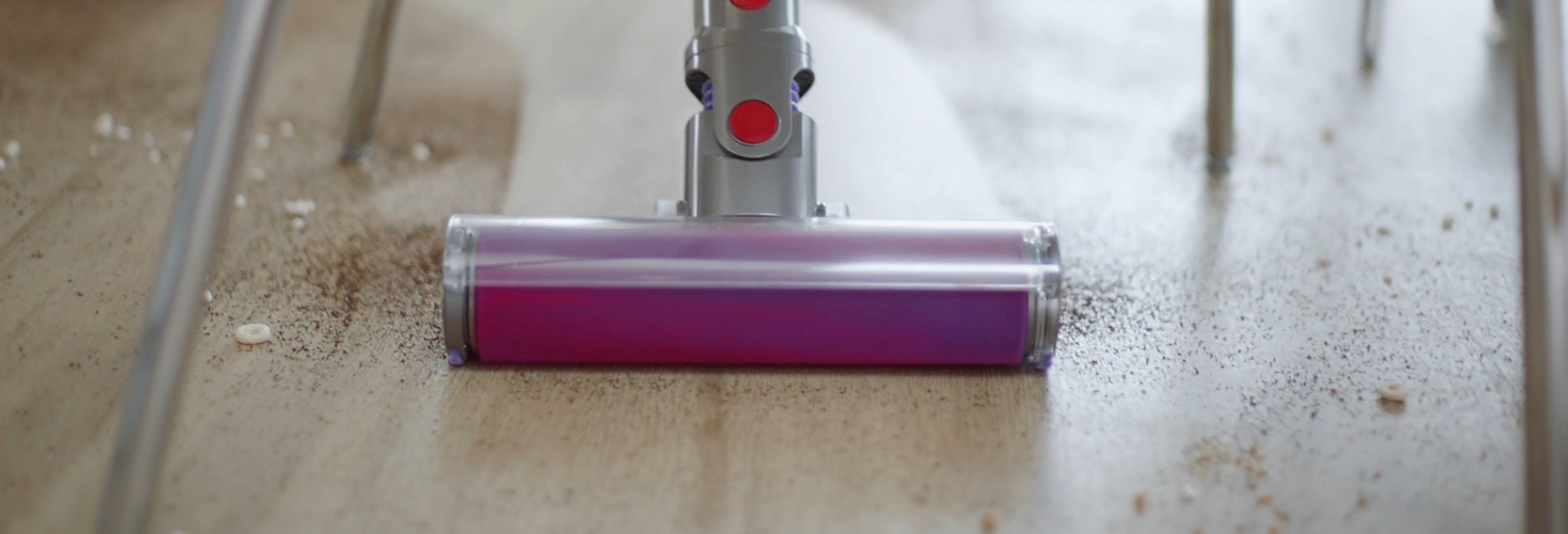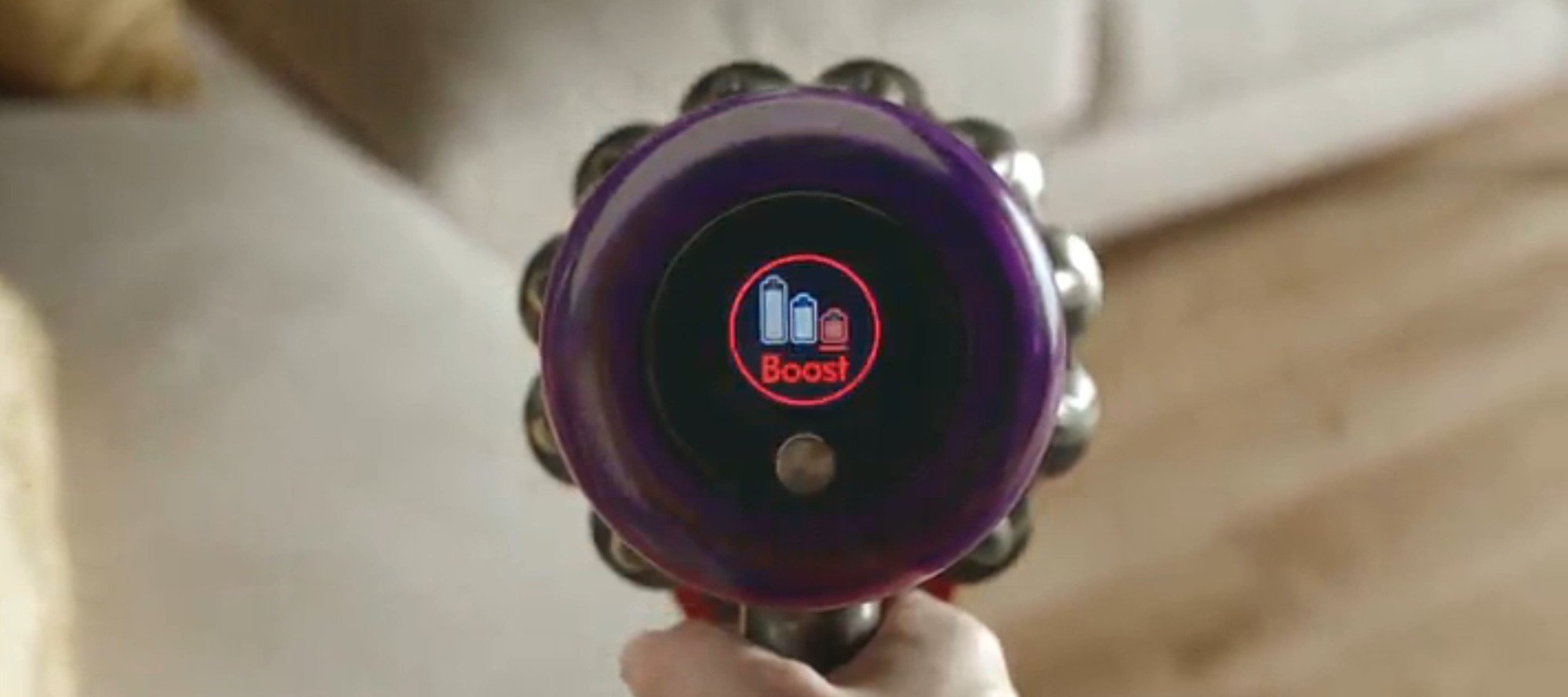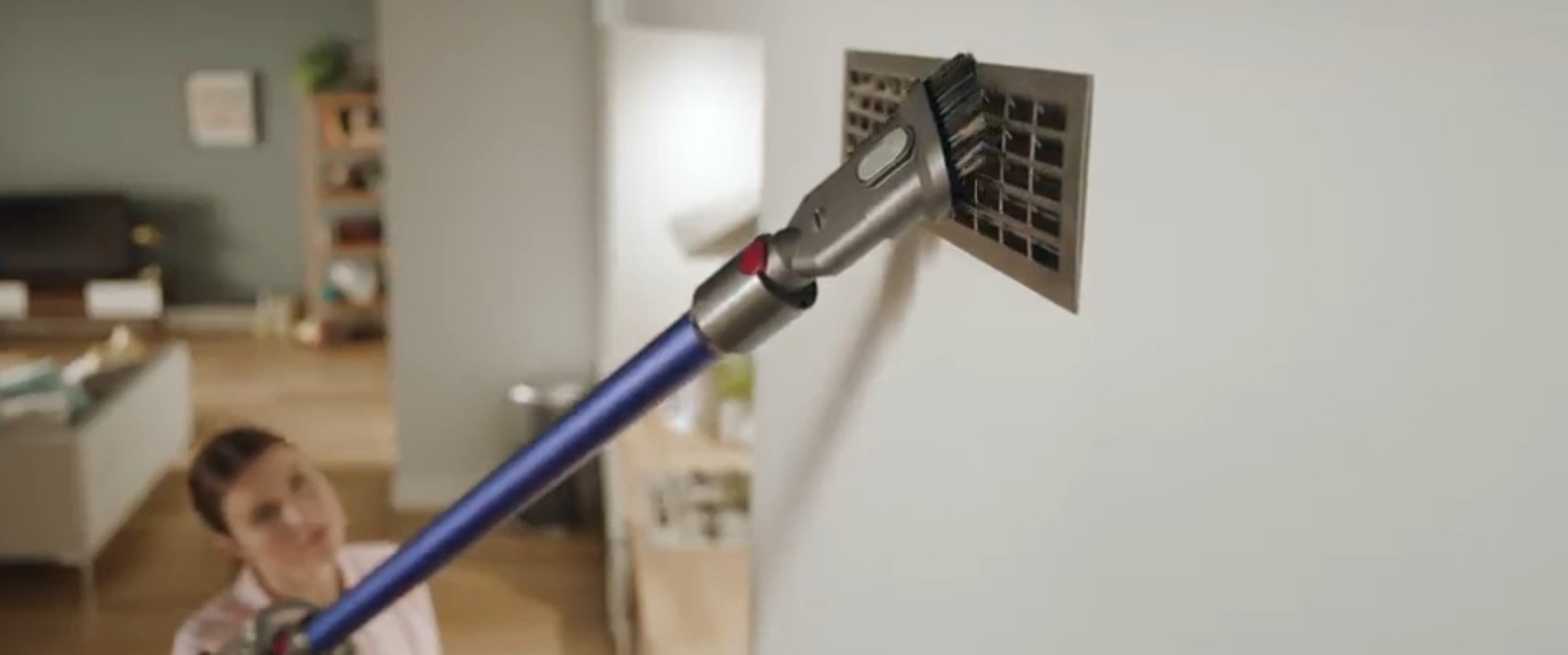Dyson has blazed a trail through the vacuum cleaner industry. Every time it releases a new line of cordless stick vacuums, the suction gets stronger and the technology becomes smarter. A new product line also means its predecessors become more affordable.

Currently, the Dyson V11 is the stick vacs everyone’s talking about. However, the Dyson V8 and V10 are still great buys. To find out how the V11s stack up against the Dyson V10s and the V8s, we conducted a nine-point feature comparison in categories such as the battery, the motor and the filtration system.
The Floor Head
Dyson V8
Dyson’s V8 Animal comes with a bristled direct-drive floor head that swiftly lifts dirt found deep within carpets. The Absolute version also has an interchangeable anti-static rolling brush covered in soft fibers to gently clean hard floors. Both floor heads are slim at 9.8 inches wide, and they’re designed to stop rotating when clogged.
Dyson V10
While the V10 Motorhead comes with the same direct-drive floor head found on the V8 models, the V10 Animal and Absolute have a 10.1-inch-wide torque-drive floor head that promises increased lifting power. The Absolute also has a switchable soft-brush floor head. An auto-shutoff mechanism in the V10s’ floor heads prevent jams and subsequent instances of overheating.
Dyson V11
Instead of two separate floor heads for different surfaces, Dyson combined two rolling brushes into one with the high-torque head on the Torque-Drive and the Animal. The 9.8-inch floor head is equipped with a manual suction switch and a dynamic load sensor that automatically changes the brushroll’s speed. As with the torque-drive and direct-drive heads, the high-torque nozzle has an auto-shutoff mechanism.
Conclusion: Dyson caters to all floor types with the V8’s interchangeable brushrolls, but the torque-drive head on the V10 Absolute and Animal have more power behind it. On the V11 models, the soft roller and bristled brushroll are combined into a single unit. Plus, the V11 floor head can automatically adjust the suction output, using sensor technology.

The Debris Bin
Dyson V8
With the V8, Dyson attempts to solve the problem of dirty hands by putting a silicone wiper to loosen packed debris between the bin’s housing and filter. The bin’s capacity is compact at 0.5 liters, and you can open it from the bottom by pulling on the lift-up release button.
Dyson V10
The V10 Animal ha a 0.5-liter debris cup, but the Absolute and the Motorhead’s cup can hold about 0.8 liters. The cup on the V10s is well-adept at emptying debris without dirtying your hands or the air due to the point-and-shoot lever that shoves particles out the bottom door.
Dyson V11
As far as the dirt cup goes, not much changed between the V10 and the V11. The cup on both the Animal and the Torque-Drive versions have a 0.8-liter capacity. Each one also has a force-producing lever that neatly sends debris from the bottom of the cup to the trash can.
Conclusion: From the V8 to the V10, the debris cup becomes 0.3 liters bigger. It also gets better at dirt removal. Changing from a lift-up to pull-up lever. Since the pull-up lever has proven to be more efficient, Dyson kept the same mechanism on the V11.

The Filtration System
Dyson V8
Inside the V8 stick vacuums, there are two filters. The main filter is a pleated high-efficiency particulate air filter that traps 99.97 percent of ultra-fine allergens. A porous post-motor filter provides extra protection against airborne contaminants. Both filters are washable and last a lifetime.
Dyson V10
HEPA is the gold-standard of filtration, and Dyson uses it for the V10’s filtration system. Instead of a separate primary and secondary filter, Dyson fused them into one, making it easier to maintain them. The filter unit is washable, and you’ll never need to replace it.
Dyson V11
Whole-machine filtration means that there are no leaks from which allergens can escape. The main HEPA filter and the secondary filter are combined into a single filtration unit. The filter is designed to last the life of the V11 stick vacuums as long as it’s cleaned regularly.
Conclusion: Dyson uses a HEPA filter in all three stick vac lines. However, the V10 and the V11 models contain a single-filter configuration that combines the main filter with the secondary one. This makes the filtration system of the two newer lines easier to maintain.

The Motor
Dyson V8
Fast and efficient were the goals for the V8 motor. Using KERS flywheel technology, which involves the electromagnetic transfer of kinetic energy, the digital V8 motor spins at a max speed of 110,000 rpm. Foam material and an almost-straight air path minimize vibrations, giving the motor longevity.
Dyson V10
PEEK, or polyether ether ketone, along with carbon-fiber composite are responsible for the increased efficiency of the digital V10 motor. Dyson moved the impeller to the front of the motor and added a cured ceramic shaft, allowing the motor to achieve a top speed of 125,000 rpm. Baffles and sound-dampening materials help reduce vibrations.
Dyson V11
The digital V11 motor is Dyson’s most powerful motor to date. Reaching speeds of 125,000 rpm, the brushless motor runs smoothly. The inclusion of more stators and magnets contribute to the motor’s strong performance, and the acoustic materials prevent noisy, damaging vibrations.
Conclusion: From the V8 to the V10, Dyson increased the motor speed by constructing the motor with different materials and reconfiguring the impeller’s placement. Although the top speed remained the same from the V10 to the V11, the motor is slightly stronger thanks to the addition of extra stators and magnets that help drive the motor.

The Suction System
Dyson V8
Suction is the whole point behind a vacuum cleaner, and the V8 models produce 115 air watts of suction, which is a lot for a stick vacuum. Two levels of 15-total cyclones mean these vacuum cleaners are well-adept at sifting fine debris.
Dyson V10
In the Dyson V10s, the suction increases to 150 air watts. The suction boost is partly due to the 100-percent-straight airway through which the debris travel. Although there are only 14 cyclones in these stick vacs, they are clustered instead of tiered to maximize the airspeed.
Dyson V11
The Dyson V11 Animal and Torque-Drive generate 185 air watts’ worth of suction, nearing the efficiency of upright and even canister vacuums. These models contain two dozen clustered cyclone channels to help filter dust and allergens, and the in-line air path reduces the likelihood of clogs.
Conclusion: Dyson manages to increase the air wattage in the V10 and again in the V11 by creating a straight path through which the air and debris travel. Clustering the cyclones in the V10 and V11 vacuums also helps enhance the suction strength.

The Cleaning Modes
Dyson V8
Whether you’re going about your daily vacuuming routine or cleaning a big mess, the V8s have a cleaning mode for the task at hand. A horizontal sliding switch on the handle lets you put the vacuum in one of two cleaning modes. Power mode provides a longer runtime. Max mode kicks up the suction but drains the battery faster.
Dyson V10
On the V10s, you get three cleaning mode options via the vertical sliding switch. Suction II mode is meant for daily vacuuming while Boost mode provides extra suction. For short-pile carpeting and hard-surface floors, you can use the Suction I mode.
Dyson V11
Dyson elevated the cleaning-mode interface with the V11 models’ touchscreen. The touchscreen on the Torque Drive and the Animal provide important maintenance reminders and let you choose a cleaning mode – the suction-adjusting Auto mode, the battery-saving Eco mode or the suction-increasing Boost mode. While the LED screen on the Animal gives a bright display, the Torque Drive features an LCD screen with a runtime countdown.
Conclusion: Those who have hard floors will appreciate the extra cleaning mode in the V10. However, the most significant advancements were made in the V11 stick vacs with their touchscreen mode-selector. The Torque Drive model boasts an LCD screen and a real-time battery tracker.
The Battery
Dyson V8
For the V8, Dyson uses a nickel-cobalt-aluminum lithium-ion battery. The 6-cell NCA battery pack provides a 40-minute working time in Power mode and a 7-minute runtime in Max mode. When used as a handheld vac, the V8’s runtime is reduced to 25 minutes. On a dead battery, the charging time takes 5 hours.
Dyson V10
The runtime for the V10s lasts for 60 minutes in Suction Mode I thanks to the addition of a 7-cell NCA lithium-ion battery. With the soft-brush and torque-drive floor head attached, the runtime decreases by 20 minutes and 25 minutes, respectively, and the battery takes 3.5 hours to recharge.
Dyson V11
Like the V10, the V11 vacuums contain a 7-cell NCA battery, giving the V11s a 1-hour runtime in Eco mode, a 30-minute runtime in Auto mode and a 15-minute runtime in Boost mode. Integrated sensors measure and transmit battery-charge information to the display screen. The tradeoff for this upgrade is a slightly longer recharge time of 4.5 hours.
Conclusion: The V10 stick vacuums offer 20 minutes more working time than the V8s, and the charging time is 1.5 hours shorter. While the V11 offers the same maximum runtime as the V10, it takes an hour longer to recharge the battery.

The Size
Dyson V8
Stick vacuums tend to be lightweight, and the V8 Animal is the lightest at 5.63 pounds. However, the V8 Absolute comes close, weighing 5.75 pounds. Both models are 49-inches-tall in floor mode, and they instantly transform into a handheld with one button click.
Dyson V10
Despite a larger battery than the V8s, Dyson manages to keep all three V10s under 6 pounds. The Motorhead weighs a mere 5.5 pounds while the Absolute and Animal weigh 5.9 pounds. Each one measures 49.2 inches tall, and the center of gravity in the wand makes it easier to use the vacuum in handheld mode.
Dyson V11
The V11 models weigh 6.68 pounds, which is a little more than their V10 and V8 counterparts. The Animal stands 49.7 inches tall, and the Torque Drive version measures 50.6 inches tall. Both models have a balanced center of gravity for better handling when lifting them above your head.
Conclusion: Out of all three stick vacuum lines and their respective models, the V10 Motorhead is the lightest and the V11s are the heaviest. However, the weight difference is only 1.2 pounds, which is barely noticeable. The V11s and the V10s are easier to manage in handheld mode due to the position of the pole’s center of gravity.
The Accessories
Dyson V8
The attachments for the V8 stick vacs are aplenty. The Absolute and the Animal come with a motorized brush, a dusting brush, a crevice tool, and a combo brush-crevice. A button press quickly detaches each accessory, and the wall-mounted charging dock offers room to store two tools.
Dyson V10
As with the V8s, the V10 Absolute and the Animal come with four accessories, including a motorized tool, a combo crevice tool, a separate crevice wand and a soft brush. The Motorhead offers the most basic vacuuming tools – a crevice wand and a combo brush-crevice tool. These vacuums also come with a wall-mounted dock with double tool storage and charging pins.
Dyson V11
The V11 Animal offers a motorized and a hard-bristled brush as well as a crevice wand and a dual-purpose brush-crevice tool. With the Torque Drive, you get all four accessories plus a soft dusting brush. Both models provide storage for two tools on the wall-hung charging dock.
Conclusion: With the exception of the V10 Motorhead, Dyson offers a varied tool selection for the V8s, V10s and V11s. Dyson switches the four-tool lineup with the V11 Animal by replacing the soft brush with a hard-bristled brush. However, the soft brush is added to the V11 Torque-Drive’s accessory range for a total count of five tools.

Related Dyson Articles
• Are Dyson Stick Vacuum Cleaners Worth the Money?
• Best Dyson Upright Vacuums
• Best Dyson Canister Vacuums
A Wrap-Up
Improvements in suction power, the number of cleaning modes, the runtime and the floor-head configuration were made from the Dyson V8 to the V10 and again from the V10 to the V11. The switch from a sliding mechanism to a touchscreen was also a major change in the V11.
Out of all three stick vacuum lines, Dyson made the biggest changes with the release of the V10 models, most of which Dyson carried to the Dyson V11 stick vacuums. The debris bin got bigger, and the filter became easier to maintain. Also, the V10 and V11 are equipped with a larger battery and fine-tuned motor.
Dyson doesn’t just slap on a new color and throw in an extra accessory to an old model and call it a redesigned vacuum. Each stick vacuum line showcases meaningful changes, and we have no doubt that the next set of stick vacs will surpass the currently available models.


If you have any questions or comments, please add them below in the comment section. Similarly, please let us know if you spot any mistakes or omissions. Thanks!
